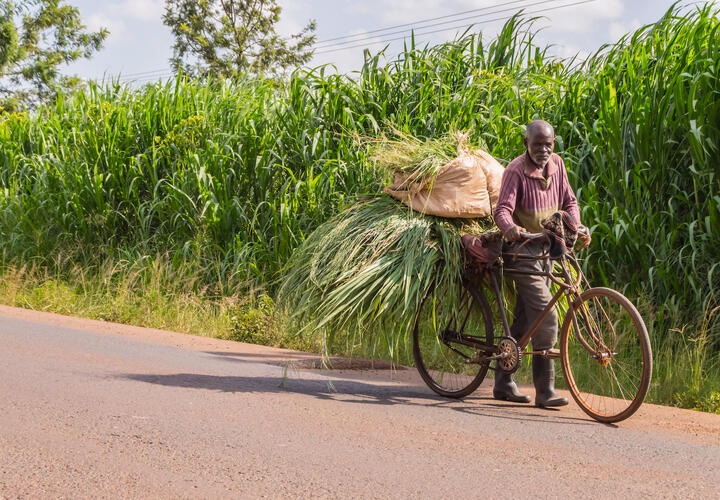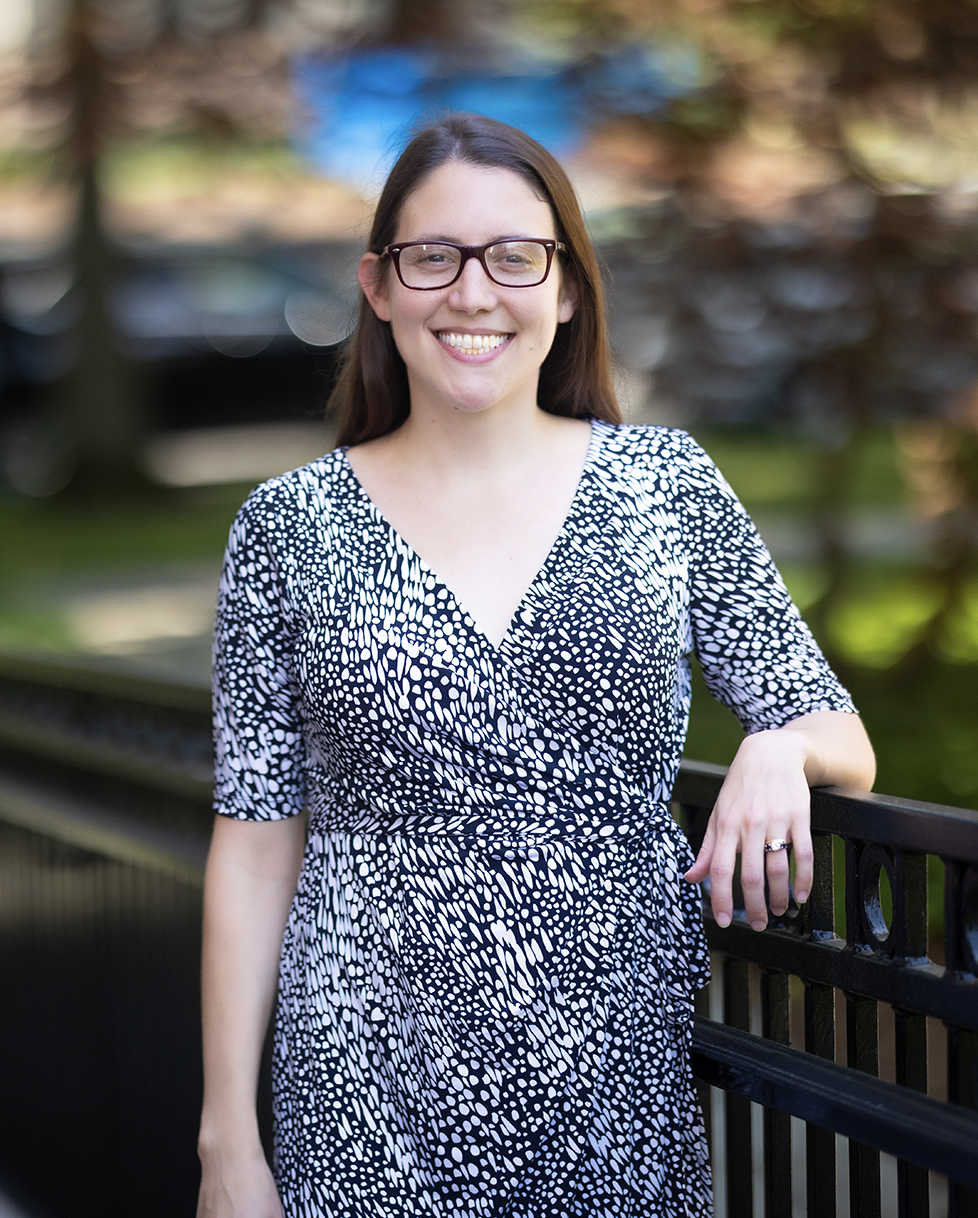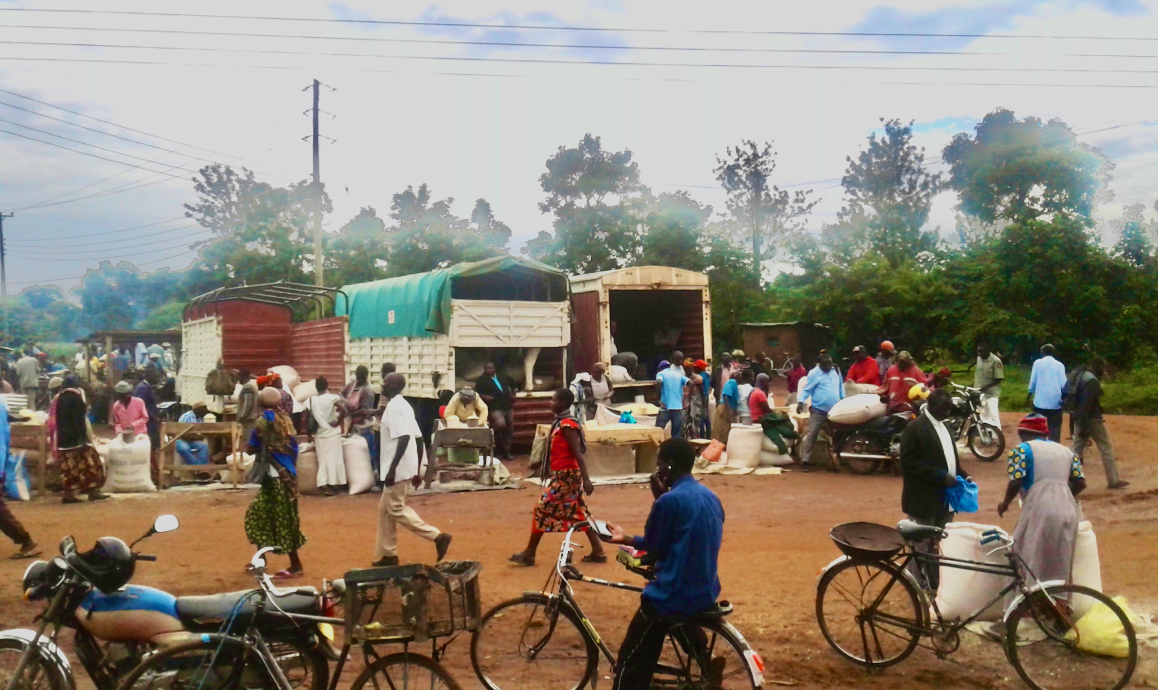Lauren Falcao Bergquist explores causes and effects of collusion in East African agricultural markets
The new EGC affiliate combines economic models and field experiments to better understand how to improve markets for food for both buyers and sellers.

In western Kenyan communities like Bungoma, maize markets are a fundamental aspect of daily life: the cereal accounts for over one third of average gross caloric intake in Kenya, 9% of average annual household expenditure, and about one-half of Kenyan households also engage in maize production.
However, some of these markets remain vulnerable to collusion among intermediaries, driving large price fluctuations across regions and seasons that result in low selling prices for farmers, high buying prices for consumers, and inefficient outcomes. As an economist with a focus on agricultural market research, Lauren Falcao Bergquist, Assistant Professor of Economics and Global Affairs and EGC affiliate, is motivated by her passion to improve the quality of life for impoverished and food insecure communities. It is her hope that “making these markets work better would result in both better livelihoods for the producers and more accessible food for consumers."
 Dan Renzetti
Dan Renzetti
In a 2020 paper published in the American Economic Review, Bergquist and co-author Michael Dinerstein from the University of Chicago were among the first to use experimental methods in addition to observation to evaluate competition models of rural agricultural markets. With this type of research and modeling, she aims to provide guidance to decision-makers to restore balance to the maize market in Kenya, and eventually extend these recommendations to improve market conditions in other regions.
 Lauren Falcao Bergquist
Lauren Falcao Bergquist
Yusuf Neggers on using technology to close information gaps and improve governance
 Julia Luckett
Julia Luckett
The EGC Visiting Scholar discusses his interdisciplinary research examining questions at the intersection of development economics and political economy, with a focus on state capacity, elections, and the delivery of public services.
A journey abroad
Bergquist spent her undergraduate years at Stanford University pursuing a dual degree in economics and political science. During the summer before her senior year, she traveled to East Africa to work with a nonprofit global health organization focused on HIV education and prevention.
Bergquist quickly became enamored with the region and the Swahili language, yet she wondered about the efficacy of programs like the one with which she was working. In an EGC interview, she said, “I was asking, how do you know that you’re doing the best good that you can do with a given budget?” This same question would drive the next stages of her career and help sculpt her academic focus on East African agricultural markets.
After college, Bergquist joined the Center for Effective Global Action (CEGA), a research organization with a mission to “improve lives through innovative research that inspires positive social change.” She then turned to projects based on Kenya’s agriculture markets as pursued a Ph.D. in Economics at UC Berkeley. She was fascinated by the microeconomic features of the market, reflected in supply and demand curves dictated by yearly harvest times. But she said agriculture markets interested her, on a more fundamental level, too: food matters for every human being on earth, for health and quality of life, especially in poor and rural communities. Bergquist saw that increasing the efficiency of these markets could have immediate and long-lasting benefits to both individual lives and entire communities in need.
After completing her PhD, Bergquist continued her research in the East African region as a Saieh Family Fellow in Economics at the Becker Friedman Institute at the University of Chicago and became involved with the Yale Research Initiative on Innovation and Scale (Y-RISE). After spending four years as Assistant Professor at University of Michigan, conducting research and teaching courses in Development Economics, she moved to Yale in July of this year.
Under the aegis of the Simon Kuznets Memorial Lecture program, the Economic Growth Center hosts short-term visiting economists for periods of 1-2 weeks starting in Fall 2022 through the Kuznets Visiting Faculty Program. Visitors contribute to the Yale development economics community during their stay by meeting with coauthors and student groups, delivering seminars, and collaborating with centers and groups across the University.

Competition and collusion in open-air markets
Bergquist’s research has distinguished her in the field of agricultural market economics due to her ability to combine experimental methods and economic theory. Beyond the scope of her published papers, Bergquist and her team have also conducted extensive focus groups and conversations on the ground in Kenya and established relationships in the village before introducing their experiment.
“I think no matter what type of work you're doing, that foundation of talking to people and hearing from their perspective what the issues are is incredibly important,” Bergquist said. “I think most good economists will spend a good amount of time doing that before they launch into quantitative work." Bergquist and her team relied heavily on translators, local partner organizations, and the trust of community members that participating in this research could return positive effects in the future.
“Lauren is a scholar who really brings a lot of tools to the table,” said Edward Miguel, Professor of Economics at UC Berkeley and Director of CEGA. “She’s able to draw on all these different tools – from theoretical models of how markets work to randomized controlled trials and original field work. It’s a really exciting research agenda.”
Upon initial surveys of the community, Bergquist and her colleagues discovered a common theory that one persistent barrier to agricultural market liberalization was the structure of competition amongst intermediaries. Local newspapers also called out “greedy middlemen, “rogue traders,” and “cartels.” Initially, Bergquist was wary of this theory – but to get to the bottom of it, she set out to better understand the nature of competition happening between intermediaries and the resulting effects on consumers.
During initial surveys, some intermediaries openly admitted to colluding with each other, and Bergquist and her team moved to investigate how and why such collusion was occurring. Through a series of experiments, including one where traders were offered monetary incentives to enter randomly selected markets, the team found that entry held high fixed costs for potential new entrants, such as buying a vehicle and other supplies.
Social barriers played a role, as well as monetary necessities. The market was friendlier to those in the know – sellers who were already acquainted with local players and were less likely to disrupt collusive practices. Outsiders less likely to enter the market were also less likely to collude. When entrants were given the resources to enter markets with no prior connections to other traders, competition increased, and the detrimental effects of collusion decreased substantially. A solution to this problem would therefore need to involve both economic and social factors.
Bergquist’s team and policymakers reached similar conclusions about the negative impacts of collusion, but the recommendations they made contrasted sharply. While the media and some government figures called for a ban on intermediaries, Bergquist and her team concluded that a more productive change may be just the opposite — lowering the barriers to entry to the market and encouraging entrance of social outsiders in order to increase competition.
Building community
In addition to communication with local policymakers and non-profits, Bergquist is also continuing this line of research in another region of East Africa. Her team worked with the developers of a new technological platform to connect buyers and sellers in Uganda who don’t know each other. Initial results suggest that traders use the platform to expand to new markets, even where they don’t have previous contacts, leading to increased competition amongst intermediaries and price convergence across markets.
As Bergquist joins the Yale Economics community she is preparing to teach a master’s class at the Jackson School of Global Affairs and helping to co-run an economic development seminar. “Thanks to generous funding from the Kuznets program, I’ve also been able to invite development economists from other universities to come for short-term visits throughout the year,” she said. “I hope they will contribute to the rich intellectual environment for students and other faculty.”
Written by Renée Sanacora